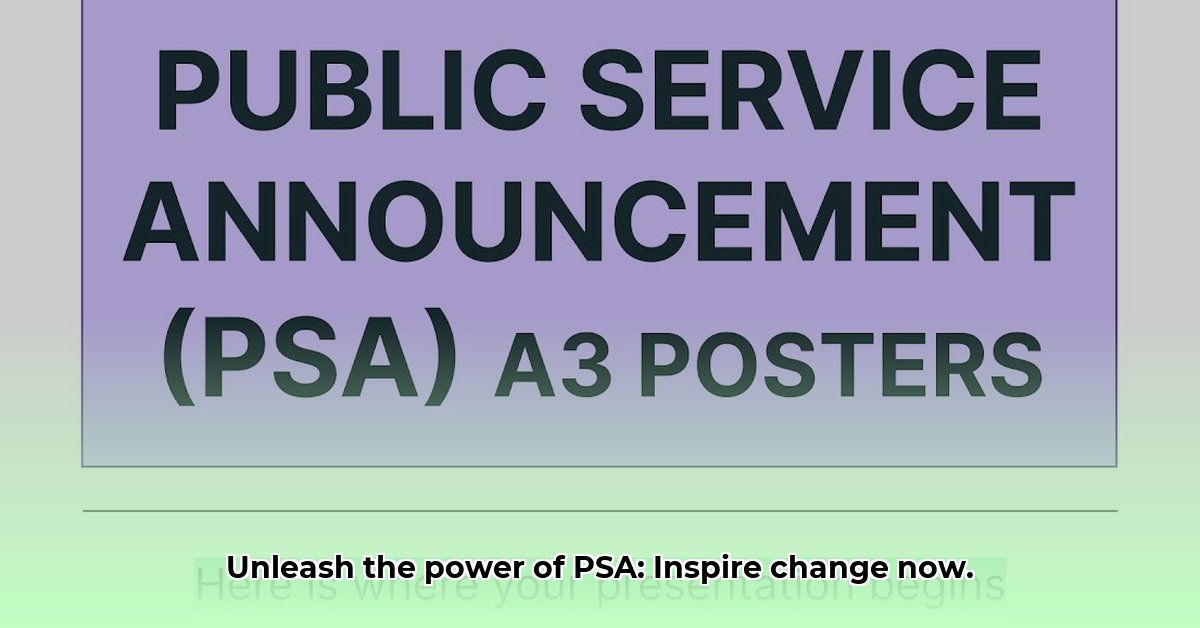Understanding the Power of PSAs
Public service announcements (PSAs)—those short, impactful messages designed to raise awareness and inspire action—play a vital role in addressing critical social issues. From promoting healthy habits to advocating for environmental protection, PSAs inform, engage, and empower individuals to make a difference. This guide explores the elements of effective PSAs, analyzes impactful examples, and provides a step-by-step process for creating your own.
Anatomy of an Effective PSA
A successful PSA is carefully crafted, blending information with emotional connection to motivate its audience. Key components include:
- Crystal-Clear Message: Distill your message to its essence. What one key takeaway should the audience remember?
- Engaging Visuals/Audio: Capture attention immediately with striking imagery, memorable music, or a compelling voiceover.
- Emotional Resonance: Connect with the audience on a human level, evoking empathy, concern, or hope. Facts alone rarely inspire action; emotion fuels engagement.
- Direct Call to Action: Guide the audience towards specific actions. Do you want them to donate, volunteer, or change a behavior? Tell them precisely how.
PSA Examples: Deconstructing Success
Analyzing real-world PSAs reveals the strategies behind their effectiveness.
Example 1: Smokey Bear (Wildfire Prevention)
- Source: U.S. Forest Service
- Message: Prevent wildfires.
- Analysis: Smokey Bear’s friendly yet authoritative persona, combined with the memorable slogan “Only You Can Prevent Wildfires,” has resonated for generations. This campaign demonstrates the long-term impact achievable through a simple, action-oriented message and a relatable character.
Example 2: “Friends Don’t Let Friends Drive Drunk” (Anti-Drunk Driving)
- Source: U.S. Department of Transportation
- Message: Don’t drink and drive.
- Analysis: This campaign effectively leverages social responsibility. By framing the act of preventing drunk driving as an act of friendship, it taps into social dynamics and peer influence.
Example 3: “Love Has No Labels” (Ad Council)
- Message: Love transcends race, religion, disability, and other differences.
- Analysis: This campaign’s social experiment, revealing diverse couples behind an X-ray screen, went viral. Its success suggests that positive messaging celebrating inclusivity resonates deeply in the digital age.
Example 4: Sandy Hook Promise’s “Back-to-School Essentials” (Gun Violence Prevention)
- Message: Advocate for gun violence prevention.
- Analysis: This PSA’s jarring twist, transitioning from a typical back-to-school ad to a depiction of a school shooting, viscerally captures attention and compels viewers to confront a difficult reality.
Example 5: The Arc’s “Say Yes!” Campaign (Disability Awareness)
- Message: Support inclusion and employment for people with intellectual and developmental disabilities.
- Analysis: Featuring real individuals sharing their work experiences, this campaign promotes empathy and challenges biases through authentic storytelling.
Crafting Your Own PSA: A Step-by-Step Guide
Ready to create your own PSA? Follow these steps:
- Identify the Issue: What social problem are you addressing? Research the issue thoroughly.
- Define Your Target Audience: Who are you trying to reach? Consider their demographics, values, and media consumption habits.
- Develop Your Key Message: What’s the single most important takeaway? Make it concise and impactful.
- Choose Your Medium: Select the most effective format for your message and target audience (video, print, radio, digital).
- Create Compelling Content: Write a script, design visuals, or compose audio that resonates emotionally and aligns with your chosen medium.
- Plan Distribution: How will you get your PSA seen or heard? Consider social media, partnerships with organizations, and contacting local media outlets.
- Measure and Evaluate: Track your PSA’s reach, engagement, and, if possible, its impact on behavior or attitudes. This data informs future campaigns.
Measuring PSA Effectiveness
Assessing a PSA’s impact extends beyond views and shares. Consider these metrics:
- Reach: How many people encountered your message?
- Engagement: Did people interact with your PSA (shares, comments, website visits)?
- Behavior Change: Did the PSA influence attitudes or actions related to the issue? (This can be challenging to measure directly but can be explored through surveys or research.)
Navigating Complexities and Uncertainties
While PSAs strive to provide accurate information, it’s crucial to acknowledge that understanding of social issues evolves. Current research may suggest certain conclusions, but ongoing studies can lead to new insights. Transparency about evolving knowledge and potential biases in data is vital.
Conclusion: The Power of a Message
By understanding the core elements of effective PSAs and thoughtfully crafting your message, you can contribute to positive change. From classic campaigns to modern masterpieces, PSAs hold the power to inform, inspire, and empower us all to build a better world. Now, what message will you share?
- Water Wheel Electric Generator Provides Free Home Electricity - December 15, 2025
- Choosing the Right Portable Hydro Turbine for Your Needs - December 14, 2025
- Best Portable Hydro Generators for Off-Grid and Outdoor Power - December 13, 2025
















